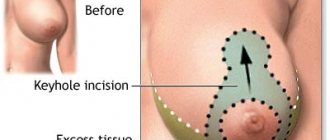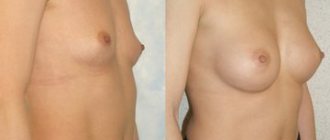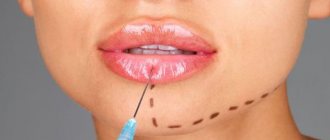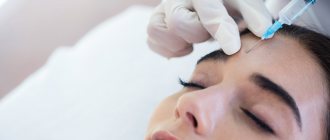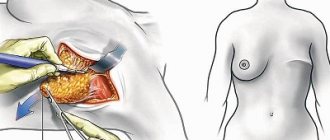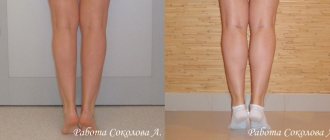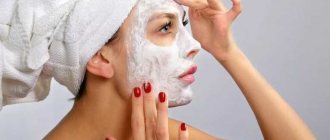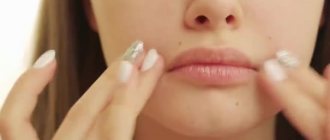For what diseases are sweat glands removed?
When sweat is released normally, this is a kind of protection against overheating. This process regulates the autonomic nervous system. Violations of the functions of the autonomic nervous system lead to the fact that any anxiety causes the release of excessive amounts of sweat. Experts have not discovered why the malfunctions occur in the body directly. Some scientists claim that it is genetics, others say that it is a matter of constant stress. There is a third point of view - the impact of the endocrine system.
Constant sweating that is not associated with physical or emotional causes is hyperhidrosis. Pathology has two forms:
- The first form is associated with infectious or oncological diseases;
- The local form is formed due to pathology of the ANS (a complex of central and peripheral nervous structures).
In the local form, the palms, feet and armpits are affected. In cosmetology, additional Botox injections are often used.
The effect of laser treatment for hyperhidrosis
The results of laser treatment for hyperhidrosis appear within a month. The patient's sweating in the treated area is completely or significantly reduced, and he is no longer bothered by the specific smell and wet marks on clothes in the armpit area.
The need to re-treat sweating with a laser occurs extremely rarely, in cases of serious dysfunction of the sweat glands. Then the operation is performed again. But not earlier than after 3 months.
If you have long wanted to solve the problem of excessive sweating once and for all, the experience and professionalism of surgeons and high-precision equipment from MedicCity are at your service. The procedure is equally effective for men and women suffering from hyperhidrosis!
read reviews about laser treatment for hyperhidrosis and other surgeries and procedures offered in our clinic here.
You can find out the cost of laser treatment for hyperhidrosis
Diseases
Most pathologies associated with the activity of sweat glands are directly related to diseases. Pathologies are distinguished:
- Anhidrosis. A pathological condition when sweat is not produced. The disease in its acute form can be the result of intestinal infection with certain pharmaceutical substances, acute diseases of an infectious nature, or pregnancy. Long-term health problems are determined by the underdevelopment of specific nerve elements or due to disorders of the skin structure;
- Oligohidrosis. Decreased sweating due to a decrease in the number or functional weakness of sweat glands. The disease often appears in elderly patients;
- Hyperhidrosis is an increased level of sweat production. There are two varieties. General sweating is expressed by the uncontrolled release of sweat over the entire plane of the body, and the localized type is high sweating of individual elements of the body (the area under the armpits, palms, soles of the feet).
Increased sweating can be observed in people with the following pathologies:
- With an increase in thyroid activity;
- Pathology caused by Koch's bacillus;
- Neuroses;
- Dermatosis affecting mainly the skin;
- Chronic inflammatory skin disease of allergic nature.
How to do curettage
Before starting the manipulations, the armpit area is marked to determine the place where the highest number of ducts that remove sweat is located. As an auxiliary method, this location is also determined using a chemical reaction.
The dry armpit is lubricated with iodine, and after drying, it is sprinkled with starch, which, in reaction with iodine and areas of increased sweating, acquires a purple color. This test is performed only on bare armpits. Even if the patient has not prepared for surgery (has not shaved), this area can be detected by the hairline.
You need to know that the purpose of surgical intervention is the complete or partial removal of excess sweat glands and the suppression of the remaining ones. The process is carried out under local anesthesia.
Removal methods
There are a large number of methods for removing glands in the axillary region. There is only one thing that connects these methods - their temporary result. An exception is Botox, which reduces the level of sweating, albeit for a short period.
For most people who suffer from underarm hyperhidrosis, the price of the procedure is also important, since the price of Botox and Dysport injections is quite high.
In severe cases, doctors use three main methods:
- Hydrocurettage;
- Body Jet device;
- Surgical method.
Hydrocurettage
It is worth noting two aspects of this procedure. Firstly, the destruction of nerve endings at the level of subcutaneous tissue, and secondly, the absolute or incomplete removal of sweat glands. Using this method, you can not only disrupt sweating, reduce the amount of sweat produced, but also significantly reduce the number of sweat glands.
Hydrocurettage differs from other similar methods. For example, when comparing the procedure with liposuction, then hydrocurettage is scraping, not suction.
Hydrocurettage refers to methods that are more often used in the axillary area, since in other areas the glands are located deeper.
The goal of this treatment option is to remove the nerve endings that lead to the sweat glands, removing them using a curettage. Elimination of sweating is carried out under general anesthesia.
Most popular: Natural and cosmetic antioxidants for youth
The curettage process begins after establishing and marking the area where profuse sweating will occur. For this you need a starch iodine test.
Despite the fact that the purpose of this method is to combat strong sweat secretion, you can use a couple of removal methods:
- Suction curettage provides the possibility of mechanical removal. A device is used that scrapes the skin of the armpits from the inside;
- Ultrasound curettage resembles a laser technique. The main difference is the effect of ultrasonic frequencies. Despite favorable patient responses to these procedures, their effectiveness has not yet been fully proven. Moreover, doctors who are familiar with these methods recommend using a couple of options simultaneously to increase the effect and prevent the problem from reoccurring;
- Laser treatment. The laser should act on the skin for no more than twenty minutes;
The postoperative period proceeds without difficulties. After three hours, you can safely return to work. But to exclude any complications, it is better to stay in the hospital under the supervision of medical workers. In extreme cases, the doctor prescribes medications. As a rule, recovery is immediate and hardly noticeable. The puncture mark is almost invisible and disappears completely after twelve months. For a week after the procedure, it is recommended to bandage the area under the arms with flexible bandages. This way, the tissues will heal faster.
How does the treatment option using the Body Jet unit work?
One of the indications for the use of the Body-Jet unit is the treatment of excessive sweat in the armpits. Now Botox injections are used for this purpose, the results of the injections last for six months, then the product must be used again. Carrying out water-jet liposuction of armpit areas using the Body-Jet unit makes it possible to mechanically eliminate sweat glands. After the procedure, the patient can go to work the next day. This method is less traumatic than the others. When the skin is pierced with a very fine needle, the glands are washed out with a jet of pressurized water generated by the Body Jet mechanism. The recovery period is a couple of days.
Prompt elimination
During the operation, absolute removal is performed using a larger incision and using a magnifying glass. After the procedure, the increased sweating disappears completely. The dimensions of the incision do not exceed eight centimeters. At the last stage of the operation, a bandage is used, which must be removed after seven days. The downside of this method is the high level of trauma, a long recovery period, and large scars after the procedure.
Contraindications for this procedure:
- Diseases in the acute stage;
- Poor absorption of glucose;
- Blood disease;
- Illnesses of a psychological nature;
- Tumors.
Sympathectomy
When the treatment of hyperhidrosis in the armpits is performed surgically, the removal of sweat glands on the palms cannot be done in this way. A separate type of procedure is used - sympathectomy. The process is carried out under endotracheal anesthesia. This is an inhalation anesthesia technique where, during surgery, medications are administered through a tube inserted into the trachea.
The effectiveness is 100% confirmed, so a repeat procedure is not required. The essence of the procedure is to suspend the activity of nerve endings with electrical impulses. The doctor blocks the activity of the sympathetic nerve trunk by applying a special titanium plug. When the doctor suspects that there is a high likelihood of complications, he may remove the plug. This way you can solve the existing difficulties with your well-being and resume the activity of the nerve trunk.
Sympathectomy is the optimal type of procedure used to remove sweat glands on the legs.
Most popular: How a miracle patch gets rid of extra centimeters
How to prepare for the process of gland removal using sympathectomy? When a person has a serious form of the disease associated with an increased level of sweat production, then medications will no longer be able to correct the situation. Therefore, removal of sweat glands is used using an extreme method - surgery. The method of removal is determined by the surgeon. Let's look at what preparation for sympathectomy involves:
- The doctor conducts an examination. In this case, the doctor outlines the problematic area;
- You should not drink alcohol, it is preferable to refrain from smoking for two weeks before the procedure;
- Do not use blood thinners;
- Get rid of hair in the areas where the procedure is being performed (this especially applies to the area under the arms) in advance.
What to do after sympathectomy
After removal of sweat glands, the patient should remember important recommendations that will help reduce possible complications:
- Reduce physical activity to a minimum. After the procedure, the body needs calmness so that healing is faster;
- The sutures must be removed by a doctor, and then only a week after the operation. The doctor examines an area of skin. You should go to the doctor for an examination so that he can monitor how the healing process is progressing;
- If an inflammatory process develops, you should immediately consult a doctor. He will prescribe medications. The funds will help in treatment to achieve lasting results and reduce the risk of complications.
Rehabilitation
The patient can go home on the day of the armpit curettage operation: he is left in the clinic only if there is special sensitivity, bleeding or suspected inflammatory process. Temporary loss of skin sensitivity and small bruises are normal and usually go away on their own. The patient comes to the clinic for dressings or, with the doctor’s permission, does them at home, independently.
You can use deodorant, take a shower, and shave your armpits about a week after the stitches are removed, if, of course, the healing process goes well.
The effect of curettage lasts from six months to several years, very individually in each case. Thanks to the procedure of removing sweat glands, the amount of sweat produced is significantly reduced, and a person forgets about the uncomfortable problems associated with wet armpits.

